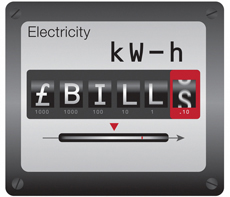 The CRC Energy Efficiency Scheme (or CRC Scheme) is designed to improve energy efficiency and cut emissions in large public and private sector organisations and it could result in fines for organisations that don’t change their ways
The CRC Energy Efficiency Scheme (or CRC Scheme) is designed to improve energy efficiency and cut emissions in large public and private sector organisations and it could result in fines for organisations that don’t change their ways
Modern organisations have many considerations and responsibilities to their customers, government and law but in recent times the implementation of ‘green’ policies has taken a new turn. In the past, companies were not restricted by environmental issues, nor were they compulsory requirements and, as a result, some organisations used being environmentally-friendly as a marketing message.
Today however, with the widespread concerns regarding climate change, governments around the world have deemed it necessary to include regulations and legislation as to the performance of business in terms of their environmental impact, which is now often referred to as the carbon footprint. Since the first G8 Climate Change Roundtable in 2005 when former PM Tony Blair led a discussion regarding a global plan of action the group has grown to include companies such as Ford, British Airways, HSBC, EDF and BP. Now, the Roundtable has a membership of 150 businesses spread across the globe which, according to Reuters, Friends of the Earth feels represents a major shift by the business community towards efforts to mitigate climate change.
So with the seeming keenness of the business community to do something about its carbon footprint and the promises made by governments to reduce carbon emissions ( the UK government introduced carbon budgets as part of the Climate Change Act 2008 to help the UK reduce greenhouse gas emissions by at least 80% by 2050) legislation has become necessary.
The CRC
The UK carbon budget places a restriction on the total amount of greenhouse gases the UK can emit over a five-year period. Under a system of carbon budgets, every tonne of greenhouse gases emitted between now and 2050 will count. Where emissions rise in one sector, the UK will have to achieve corresponding falls in another.
The CRC affects large public and private sector organisations across the UK, together responsible for around 10% of the UK’s greenhouse gas emissions. Participants include supermarkets, water companies, banks, local authorities and all central government departments.
The scheme is designed to target emissions not already covered by Climate Change Agreements (CCAs) and the EU Emissions Trading System (EU ETS) and features a range of drivers to encourage organisations to develop energy management strategies that promote a better understanding of energy usage.
Organisations that meet the qualification criteria are required to participate, and must buy allowances for every tonne of carbon they emit.
Qualification for the scheme is based on electricity usage. For Phase 2, organisations will qualify if, during the qualification year, they consumed over 6,000 megawatt-hours (MWh) of qualifying electricity through settled half-hourly meters.
Organisations that meet the qualification threshold must register using the CRC Registry, which is administered by the Environment Agency. Qualifying organisations have to comply legally with the scheme or face financial and other penalties.
Organisations which participate within the CRC are required to monitor their energy use, and report their energy supplies annually. The Environment Agency’s reporting system applies emissions factors to calculate participants’ carbon dioxide (CO2) emissions on the basis of this information. Participants must purchase and surrender allowances to offset their emissions. Allowances can either be bought at annual fixed-price sales, or traded on the secondary market. One allowance must be surrendered for each tonne of CO2 emitted. The allowance price in Phase 1 has been set at £12 per tonne of CO2.
Fines for failing to report on annual emissions could increase. Currently organisations are fined a one-off payment of £5,000; paying a further £500 for each subsequent day reports are delayed, up to a maximum of 40 working days – or £20,000 so there is quite a financial motive for compliance as well as the environmental factor.
What can your customers do?
So your customer is in charge of fire and security protection at a large hospital. They have a constant flow of people entering and leaving the site and a host of potential risks to deal with. How can they possibly begin to consider the hospital’s carbon footprint? And how much will it cost them to follow the legislation?
A report by CMR Consultants states: “Despite its simplification, the CRC can impose a significant cost and resource burden on an organisation. In addition, the scheme is being amended on a regular basis by the Government and there appears to be no sign of this changing.” It also recommends developing a carbon management strategy, budget for the energy consumption allowances fees, and investigate the most effective ways of introducing energy-saving measures.
You might think that energy-saving measures are not possible for 24/7 fire and security systems, however there are simple alternatives that you could specify that will help your customers avoid CRC fines. In such cases it would certainly prove prudent to look at alternative forms of power supply such as switched mode technology, already providing savings for various sectors of the market.
